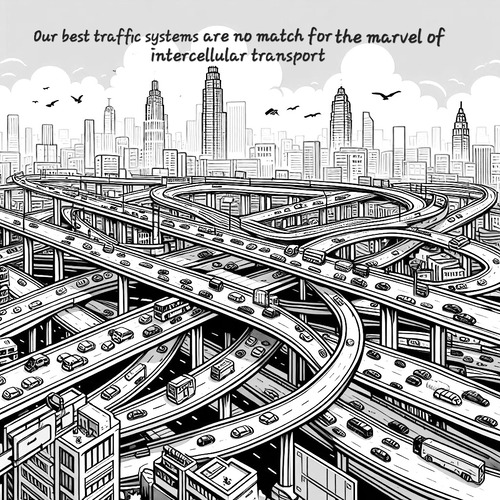Blueprints of Life: Why Cellular Precision Demands a Designer
In the microscopic world of the cell, an intricate ballet unfolds every moment of every day. Molecules move with purpose, proteins fold with precision, and errors are detected and corrected with astonishing accuracy. As our scientific instruments and methods have advanced, we’ve gained unprecedented insights into these cellular processes—and what we’re discovering presents a profound challenge to purely naturalistic explanations of life’s origin.
CELLULAR PRECISION IN PROTEIN FOLDING
Consider the marvel of protein folding. Proteins begin as simple chains of amino acids but must fold into specific three-dimensional shapes to function properly. Recent research has revealed just how remarkable the process truly is.
A 2023 study published in Nature Structural & Molecular Biology demonstrated the folding process isn’t merely a passive physical event but is actively guided by molecular chaperones. These chaperones don’t just prevent misfolding—they actively guide proteins through specific folding pathways, functioning like skilled craftsmen rather than passive tools.
Even more fascinating is the discovery that cells maintain an elaborate network of quality control mechanisms to detect and correct misfolded proteins. The ubiquitin-proteasome system tags and eliminates misfolded proteins with a precision that would make the most advanced human-engineered quality control systems seem primitive by comparison.
How could such an interdependent system of folding, checking, and correcting evolve through gradual, unguided processes? Each component relies on others to function properly. Without the quality control mechanisms, misfolded proteins would accumulate and cause cellular damage. And without proper folding mechanisms, there would be no functional proteins to begin with.
THE MARVEL OF INTRACELLULAR TRANSPORT
Imagine a bustling city with millions of packages being delivered to precise locations without a single address error. This miracle happens inside every cell of your body through an intricate transportation system that defies evolutionary explanation.
- Molecular Motors—Nature’s Delivery Vehicles: Proteins kinesin and dynein function as molecular “trucks” that walk along cellular highways carrying specific cargo. These motors consume cellular energy (ATP) with near-perfect efficiency rates that exceed human-engineered motors, operating with a precision that points to purposeful engineering rather than chance development.
- Directional Trafficking Networks: Recent research published in Cell in 2024 revealed cellular highways are directionally organised, with specific “on-ramps” and “exit routes” for each cellular destination. This traffic system requires not just physical components but encoded instructions for navigation that cannot be explained through gradual evolutionary processes.
- Cargo Recognition Systems: Each molecular motor somehow “knows” exactly which cargo to pick up and where to deliver it through complex lock-and-key recognition systems. The precise matching between hundreds of different motors and thousands of cargo types represents an information challenge that random mutations cannot plausibly solve.
- Coordinated Transport Regulation: Multiple transport systems synchronise their activities through elaborate signaling networks that respond to cellular needs in real-time. This coordination involves hundreds of regulatory proteins working in harmony, presenting an irreducibly complex system where removing any component would cause the entire transport network to fail.
- Energy Efficiency Mechanisms: Cellular transport systems include sophisticated energy conservation features that activate motors only when needed and recycle components when not in use. These efficiency mechanisms parallel the best of human engineering design principles but exist at a nanoscale level of sophistication that exceeds our most advanced technologies.
CELLULAR PRECISION: IN QUALITY CONTROL
Cells maintain sophisticated quality control mechanisms that monitor and maintain cellular function. Recent research has uncovered layers of complexity in these systems that defy explanation through random processes.
A study published in Science in 2023 revealed that cells employ a hierarchical system of stress responses. When damage occurs, cells don’t just react blindly—they assess the type and extent of damage and initiate specific response pathways tailored to the situation.
The DNA repair mechanisms are particularly fascinating. Enzymes patrol the DNA, detecting and repairing damage with extraordinary precision. Some enzymes can detect a single incorrect base pair from among billions of correct ones—a level of accuracy that would be impossible without precise engineering.
These quality control systems operate as integrated networks. Each component must recognise specific signals, perform its function at the right time, and coordinate with other components. The probability of such systems arising through random mutations and selection stretches credulity to breaking point.
INFORMATION PROCESSING IN CELLS
The cell’s ability to process, store, and respond to information represents one of the strongest arguments for intelligent design. Modern research reveals cells operate as sophisticated biological computers with capabilities that defy materialistic explanations.
- Signal Transduction Cascades: Cells convert external signals into precise internal responses through elaborate multi-step pathways. A groundbreaking study in Cell Systems in 2024 demonstrated these cascades function with error-correction capabilities and amplification efficiency that matches our best-engineered systems, yet exist at a molecular scale impossible to achieve through random processes.
- Epigenetic Regulatory Networks: Like DNA, cells maintain complex systems for activating and silencing genes that can be inherited across generations. These epigenetic markers function as a sophisticated programming layer that allows the same genetic code to produce different cell types, demonstrating a level of information management that requires foresight incompatible with unguided evolution.
- Cellular Memory Systems: Cells can “remember” previous environmental exposures and adapt their responses accordingly through complex biochemical feedback mechanisms. This cellular memory requires not just physical components but specific encoding and retrieval systems that parallel computer memory but exceed it in efficiency, pointing to advanced engineering principles.
- Noise Reduction Mechanisms: Despite the random thermal motion of molecules, cells maintain extraordinarily precise signaling with special noise-filtering capabilities. Recent research has shown that cells employ sophisticated error-correction algorithms that would be the envy of any human communications engineer, featuring redundancy and verification impossible to explain through natural selection alone.
- Intercellular Communication Networks: Cells coordinate their activities through elaborate communication systems involving hundreds of precisely matched receptor-signal pairs. The specificity of these communication channels prevents cross-talk between different pathways, demonstrating a level of design sophistication that cannot arise incrementally since partial communication systems would provide no selective advantage.
CELLULAR PRECISION: DESIGN INFERENCE
When we step back to consider the totality of what we’ve discovered about cellular function, a clear picture emerges. The precision, coordination, and information processing capabilities of cells point unmistakably to intelligent design.
Consider the concept of irreducible complexity. Many cellular systems consist of multiple components that must function together. Remove any component, and the system fails. Such systems could not have evolved through a gradual process, as intermediate forms would lack function and provide no selective advantage.
The probabilistic hurdles for naturalistic explanations are insurmountable. The likelihood of even a single functional protein forming by chance is astronomically small. When we consider the probability of multiple proteins forming and assembling into functional systems, the numbers become so vanishingly small as to be effectively impossible.
Design offers a more reasonable explanation. When we observe complex, information-rich systems in any other context, we immediately recognize them as the products of intelligence. Why should cell biology be an exception?
CONCLUSION: CELLULAR PRECISION
The recent advances in our understanding of cellular processes have not made the case for naturalistic evolution stronger—they’ve made it weaker. As we peel back the layers of cellular complexity, we find more and more evidence pointing to purposeful design.
This doesn’t mean we should abandon scientific inquiry. On the contrary, a design perspective can inspire new avenues of research. If cells are designed systems, we can learn from their engineering principles and apply them to human technology.
The evidence for design in cell biology isn’t based on gaps in our knowledge but on what we do know. The more we learn about cellular precision, the stronger the case for design becomes…
CELLULAR PRECISION: RELATED FAQs
How do cellular repair mechanisms compare to human-engineered repair systems? Cellular repair systems operate with a level of sophistication that makes our most advanced self-healing materials look primitive by comparison. When DNA is damaged, specialised enzymes not only detect the precise location of damage but also determine which type of repair mechanism to deploy based on the specific nature of the damage. These systems can repair thousands of DNA lesions per cell per day with near-perfect accuracy, a feat human engineers haven’t been able to replicate at any scale.
Could cellular complexity have developed through a step-by-step evolutionary process? Many cellular systems demonstrate irreducible complexity, where all components must be present simultaneously for the system to function. The bacterial flagellum, for example, requires over 40 precisely matched proteins working in concert—remove any one, and the entire system fails. This poses an insurmountable challenge for gradual evolutionary development since partial systems provide no selective advantage and would therefore not be preserved by natural selection.
How do cells manage energy resources in ways that suggest design? Cells employ sophisticated energy management systems that dynamically allocate resources based on changing conditions and priorities. Recent research has revealed that cells maintain elaborate feedback networks that monitor energy status and adjust metabolic pathways accordingly, with efficiencies exceeding our best artificial systems. These cellular power management systems include predictive capabilities that anticipate energy needs before they arise—a hallmark of intelligent design rather than reactive evolutionary processes.
What does cellular adaptation tell us about design vs. evolution? Cells possess remarkable adaptation capabilities through pre-programmed response pathways that activate under specific environmental conditions. A 2023 study in Nature Cell Biology revealed that these adaptive responses aren’t random mutations but controlled processes that draw on information already encoded in the genome. This suggests cells were designed with foresight to adapt to changing conditions within specific parameters, rather than evolving through random genetic changes.
How do the information storage capabilities of DNA point to design? DNA storage density exceeds any human technology by orders of magnitude, storing the equivalent of 1.5 gigabytes of information in a space one millionth the size of a pinhead. Beyond mere storage, DNA includes sophisticated error-correction mechanisms, indexing systems, and compression algorithms that allow for efficient retrieval and utilisation of genetic information. The informational aspects of DNA cannot be explained by chemistry and physics alone, just as the Information in a book cannot be explained by the properties of ink and paper.
What does cellular development reveal about design principles? The development of a complete organism from a single cell represents one of the most sophisticated engineering feats in nature. This process requires not just the blueprints (DNA) but elaborate execution systems that ensure each cell differentiates properly according to its position and timing. Recent developmental biology research has uncovered multiple layers of regulation that coordinate this process with precision that exceeds our most advanced manufacturing systems, suggesting a level of engineering that defies evolutionary explanation.
How does cellular waste management demonstrate design sophistication? Cells maintain elaborate recycling systems that break down damaged components and reuse their building blocks with near-perfect efficiency. The autophagy process (which won a Nobel Prize in 2016) selectively targets damaged organelles for recycling while preserving healthy ones—a feat requiring recognition capabilities and precision that exceeds our most sophisticated recycling technologies. These cellular waste management systems operate with a circular economy approach that human engineers have only recently begun to appreciate but have yet to replicate at any comparable level of efficiency.
CELLULAR PRECISION: OUR RELATED POSTS
- The Woodpecker’s Design: How Nature’s Headbanger Defies Evolution
- Saturn, the Ringed Planet: Challenge to Random Evolution
- Evidence that Glows: How Bioluminescence Reveals Design
- Nature’s Perfect Motor: How the Bacterial Flagellum Defies Evolution
- Too Perfect to Be Random: The Giraffe’s Remarkable Design
Editor's Pick

Paul’s Mandate for Men: Headship Or Servant Leadership? Or Both?
Modern Christianity has fallen into a trap. We've created an either/or battle between "headship" and "servant leadership," as if these [...]

Should We Stop Using Male Pronouns for God? Why Do We Say No?
A friend of ours arrived eagerly at his first theology class in seminary. But he quickly discovered something troubling: the [...]

Did Old Testament Law Force Women to Marry their Rapists?
**Editor’s Note: This post is part of our series, ‘Satan’s Lies: Common Deceptions in the Church Today’… Viral misinformation abounds [...]

From Danvers To Nashville: Two Statements, One Biblical Vision
30 years separate the Danvers Statement on Biblical Manhood and Womanhood (1987) and the Nashville Statement on Human Sexuality (2017). [...]

The Nashville Statement: Why Affirm It Despite Media Backlash?
WHY DO REFORMED CHRISTIANS STAND BY THIS STATEMENT ON MARRIAGE AND GENDER? When the Nashville Statement was released in 2017, [...]

Who Is Belial? Solving The 2 Corinthians 6:15 Mystery
Belial: This name from the pages of Scripture chills the soul. Who is this mysterious figure Paul invokes in 2 [...]

Celibacy Or Castration: What Jesus Really Means in Matthew 19:12
One of Scripture's most shocking misinterpretations led theologian Origen to castrate himself in the third century. His tragic mistake? Taking [...]

Philippians 4:13: Did Paul Really Mean We Can Do ALL Things?
"I can do all things through Christ who strengthens me." It's on gym walls, graduation cards, and motivational posters everywhere. [...]

The Ordinary Means of Grace: Why Are They Indispensable?
ORDINARY MEANS FOR EXTRAORDINARY TRANSFORMATION What if God's most powerful work in believers' lives happens through the most ordinary activities? [...]

Is the Bible God’s Word? Or Does It Only Contain God’s Word?
The authority of Scripture stands at the crossroads of modern Christianity. While some argue the Bible merely contains God’s Word [...]
SUPPORT US:
Feel the Holy Spirit's gentle nudge to partner with us?
Donate Online:
Account Name: TRUTHS TO DIE FOR FOUNDATION
Account Number: 10243565459
Bank IFSC: IDFB0043391
Bank Name: IDFC FIRST BANK






